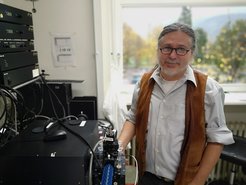"It’s like the cogs and wheels in alarm clocks!"
Jochen Reinstein, Research Group Leader “Protein Assembly”, on his story in life sciences - an interview.

What first got you interested in science?
Even as a small child I always wanted to know how things work and what lies behind that. An alarm clock was an early victim. It was taken apart, but I didn’t manage to put it back together again. My parents tried to channel my curiosity by means of Kosmos science toys. I liked the chemistry set most (along with pyrolytic experiments that the manufacturer had not reckoned with).
What did you study, and what did you do after that?
I started my studies here in Heidelberg, getting a diploma in biology, though biochemistry actually interested me more. After my doctorate on the mechanism of adenylate kinase, with Alfred Wittinghofer in Ken Holmes’s department here at the MPI for Medical Research, I went as a postdoc to Brandeis University in Boston, to work with William P. Jencks on the calcium pump of the sarcoplasmatic reticulum. In 1992, I came back to Max Planck, and became a group leader in Roger Goody’s department at the MPI for Molecular Physiology in Dortmund. For the first time I could do my own thing, and worked mainly on molecular chaperones and protein folding.
What led you to your current research topic?
Molecular motors and the structure and folding of proteins are topics that I was always involved in: so-called assembly processes. Until a few years ago the emphasis was on individual proteins and molecular chaperones, but now it is on higher-level, supramolecular processes.
Your research in a nutshell?
I study how biological structures form and make molecular functions possible. It’s like the cogs and wheels that I originally studied in alarm clocks! Except that here it is the interplay of atoms and molecules. Unfortunately, we still are often not in a position to build these assemblies so that they actually work.
What is fascinating about this?
If we really understand the concepts behind the working of things, such as molecular machines and complexes, then we can use this knowledge to build new things.
What does a normal working day look like for you?
Nowadays I spend a lot of time in my office, because the bureaucracy has increased so much. But I get into the lab now and then, and at present my group is so small that that happens relatively often.

What do you particularly like about our institute? What made you decide on the MPI and Heidelberg?
I particularly like the old institute building. it breathes history and feels like home. Compared to many modern concrete buildings it has a good feeling to it. And, with only 2-3 floors it is relatively low, which greatly encourages interactions with other groups because stairs and elevators are less of an obstacle. In my experience, scientists diffuse much better horizontally than vertically. I have never regretted having spent almost my entire years of research in the Max Planck Society: the freedom and resources are quite unique.
What advice would you give to young scientists starting to work in your area?
- Decide on something, stick to it, and fight for your goals. Hard work is part of this, and setbacks are also. But the satisfaction when something works out is all the greater.
- Always be willing to question your own work and progress.
And your advice to young women scientists?
Networking: work with other women scientists, and form good collaborations.
How should science aim to serve society?
Science should provide new basic knowledge that other people can use – to do new things and do good in the world. Unfortunately, knowledge can always be misused – this is unavoidable.
What would people be surprised to find out about you?
Probably my age: people generally think that I’m 10 years younger than I really am. This was sometimes a trap for students who thought I was one of them and complained about “useless knowledge” – and were astonished when I got up and gave the seminar. But admittedly that was quite a while back….

